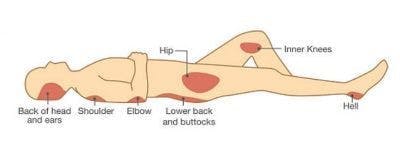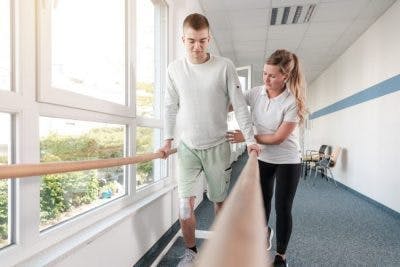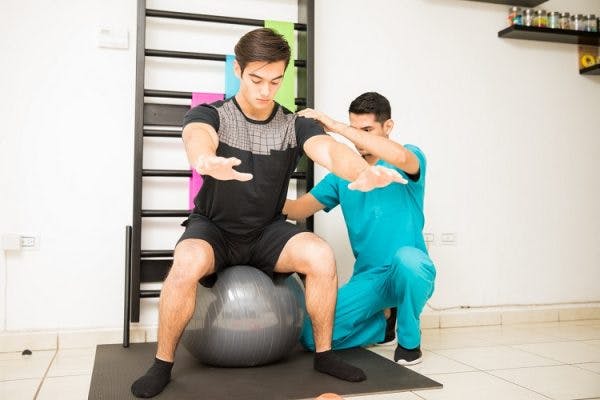A T12 spinal cord injury affects lower body functions such as walking and bowel and bladder functions. Fortunately, individuals with T12 spinal cord injuries generally have normal, full functioning of their upper bodies, which allows a great deal of independence.
To help you understand how a T12 SCI can affect your day-to-day life, this article will include potential functional outcomes and recovery outlook.
Muscles Affected by T12 Spinal Cord Injury

Photo Credit: Ralf Stephan
The thoracic region of your spinal cord is divided into 12 segments that innervate the muscles in your trunk.
T12 spinal cord injury patients generally have full function in their upper limbs and trunk. The T12 nerve roots innervate the very lower abdominal muscles.
Therefore, individuals with T12 SCIs will focus on rehabilitation for the lower half of their body.
Want 15 pages of SCI recovery exercises in PDF form? Click here to download our free SCI Rehab Exercise ebook now (link opens a pop up for uninterrupted reading)
Your spinal cord relays messages between your brain and body. After a spinal cord injury, these messages may not be able to make a connection past the site of injury.
Therefore, the severity of your spinal cord injury will determine how much motor control or sensation you have below your level of injury.
The more spared neural pathways there are at the site of injury, the more functions will be preserved.
T12 Spinal Cord Injury Complications
T12 spinal cord injuries will affect sensation and mobility in the lower half of the body. Below, we’ll discuss 5 possible complications that can occur in individuals with T12 SCIs:
1. Bladder and Bowel Dysfunction
Inability to control the bowel and bladder muscles or inability to feel when they are full can cause leakage that you cannot feel or be aware of.
Catheterization, bladder augmentation surgery, and medications can help control and better predict bowel and bladder movements.
2. Reduced Bone and Muscle Density

Depending on the severity of your SCI, paralysis may prevent you from moving as much or often as you’d like.
This disuse or lack of use will cause your bones and muscles to shrink and weaken, which can increase your risk of injury.
3. Difficulties Standing or Walking
Paralysis (even partial paralysis) can alter your ability to balance on two feet. Some T12 spinal cord injury patients with less severe injuries may be able to recover walking through gait training.
This can involve the use of walking aides like walkers or special equipment like parallel bars and weight-bearing treadmills.
4. Pressure Ulcers

Physical inactivity due to paralysis can cause pressure ulcers.
When you stay in the same position for too long, your body sends signals to the brain communicating that there’s too much pressure being placed on that area of the body. This is what makes us feel restless and antsy.
However, after a spinal cord injury, you may not be able to feel these sensations, which makes it easier to forget to change positions.
Prolonged pressure on the body can cut off circulation, causing tissues to become inflamed and skin to gradually break down, with risk of infection.
Pressure ulcers are most common in bony areas like the knees, ankles, hips, and elbows. To prevent them from forming, try to move around frequently and inspect your skin regularly.
5. Spasticity and Pain
Spasticity is when your muscles involuntarily contract.
Many patients experience spasticity after an SCI because messages between their brain and body are not being communicated properly.
Continuous muscle contractions can be painful and interfere with movements.
However, spasticity and pain can be good signs of recovery. They help indicate that neural pathways between your brain, spinal cord, and areas below your level of injury still exist.
The more spared neural pathways you have, the greater your potential for recovery.
T12 Spinal Cord Injury Recovery

Rehabilitation after a T12 spinal cord injury primarily consists of physical and occupational therapy. These rehabilitative therapies will assess your functional abilities and strive towards maximizing your mobility and independence.
In physical therapy, you’ll work on improving your mobility through targeted exercises.
The goal of occupational therapy is to regain your independence by practicing activities of daily living like brushing your teeth and getting dressed. This will develop your fine motor skills and you’ll learn new techniques to perform these activities.
Recovery from any level of spinal cord injury focuses on promoting neuroplasticity. Neuroplasticity is your central nervous system’s ability to adapt by rewiring itself.
The more you repeat a movement, the more you stimulate neuroplasticity in spared neural pathways. With enough practice, your brain, spinal cord, and body can learn to work in sync again. Ultimately, you’re relearning how to move again by promoting neural adaptation.
Understanding T12 Spinal Cord Injuries
Spinal cord injuries require you to do things differently, but the key is to focus on what you can do.
Individuals with T12 SCIs can still be independent because of normal upper body functions.
The less severe your spinal cord injury is, the better your chances of recovery are. With massed practice, spared neural pathways at your injury site can reorganize themselves and help recover functions weakened by SCI.
Incomplete spinal cord injury rehabilitation isn’t easy, but it’s possible to improve your mobility with targeted therapy.











